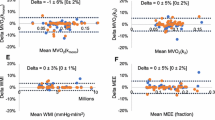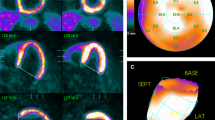Abstract
Background
Myocardial oxygen consumption can be determined by using carbon 11-acetate (11C-acetate) and positron emission tomography (PET). The aim of this study was to validate planar 11C-acetate scintigraphy in healthy individuals by relating the myocardial clearance rate of dynamic 11C-acetate scintigraphy with the rate-pressure product, which is used as a measure of cardiac work. Also, the optimal curve-fitting procedure of the time-activity curve and the intraobserver and interobserver variation of determining the clearance rates were assessed.
Methods and Results
Six subjects were studied at rest, and seven subjects were studied during dobutamine stimulation. Imaging was performed with a planar camera equipped with highenergy collimators for 45 minutes after the injection of 185 MBq of 11C-acetate. Myocardial time-activity curves were corrected for decay. During the study, heart rates and blood pressures were measured to calculate the rate-pressure product.
Myocardial time-activity curves showed a clear biphasic pattern. Clearance rates were expressed in k values. The best fitting procedure, as assessed by means of the lowest error of k and the best correlation with the rate-pressure product, proved to be a monoexponential fit on the first part of the time-activity curve (kmono). Subjects studied during dobutamine infusion had significantly higher rate-pressure product (15.0±2.1*103 vs 8.6±1.2*103, P<.001) and 11C-acetate clearance rates (kmono=0.0657±0.0110 vs 0.0313±0.0056, P<.0001) than subjects studied at rest. There was low intraobserver and interobserver variation in determining kmono values. A significant correlation between the rate-pressure product and the monoexponential clearance rate was found (kmono=5.11*10−6*RPP-0.012; r=0.94, P<.001).
Conclusions
The estimation of myocardial oxygen consumption is feasible with planar 11C-acetate scintigraphy. Clearance rates and the relation with the rate-pressure product are similar to those reported in PET studies. This technique may be used for the assessment and follow-up of global myocardial metabolic abnormalities, eg, in patients with hypertensive heart disease, cardiomyopathy, myocarditis, and valvular disease.
Similar content being viewed by others
References
Brown M, Marshall DR, Sobel BE, Bergmann SR. Delineation of myocardial oxygen utilization with carbon-11-labeled acetate. Circulation 1987;76:687–96.
Buxton DB, Schwaiger M, Nguyen A, Phelps ME, Schelbert HR. Radiolabeled acetate as a tracer of myocardial tricarboxylic acid cycle flux. Circ Res 1988;63:628–34.
Armbrecht JJ, Buxton DB, Schelbert HR. Validation of [1-11C]acetate as a tracer for noninvasive assessment of oxidative metabolism with positron emission tomography in normal, ischemic, postischemic, and hyperemic canine myocardium. Circulation 1990;81:1594–605.
Brown MA, Myears DW, Bergmann SR. Noninvasive assessment of canine myocardial oxidative metabolism with carbon-11 acetate and positron emission tomography. J Am Coll Cardiol 1988;12:1054–63.
Buxton DB, Nienaber CA, Luxen A, et al. Noninvasive quantitation of regional myocardial oxygen consumption in vivo with [1-11C]acetate and dynamic positron emission tomography. Circulation 1989;79:134–42.
Brown MA, Myears DW, Bergmann SR. Validity of estimates of myocardial oxidative metabolism with carbon-11 acetate and positron emission tomography despite altered patterns of substrate utilization. J Nucl Med 1989;30:187–93.
Henes CG, Bergmann SR, Walsh MN, Sobel BE, Geltman EM. Assessment of myocardial oxidative metabolic reserve with positron emission tomography and carbon-11 acetate. J Nucl Med 1989;30:1489–99.
Armbrocht JJ, Buxton DB, Brunken RC, Phelps ME, Schelbert HR. Regional myocardial oxygen consumption determined noninvasively in humans with [1-11C]acetate and dynamic positron tomography. Circulation 1989;80:863–72.
Tamaki N, Magata Y, Takahashi N, et al. Myocardial oxidative metabolism in normal subjects in fasting, glucose loading and dobutamine infusion states. Ann Nucl Med 1992;6:221–8.
Vanoverschelde J-LJ, Wijns W, Essamri B, et al. Hemodynamic and mechanical determinants of myocardial O2 consumption in normal human heart: Effects of dobutamine. Am J Physiol 1993;265:H1884–92.
Krivokapich J, Huang S-C, Schelbert HR. Assessment of the effects of dobutamine on myocardial blood flow and oxidative metabolism in normal human subjects using nitrogen-13 ammonia and carbon-11 acetate. Am J Cardiol 1993;71:1351–6.
Tamaki N, Magata Y, Takahashi N, et al. Oxidative metabolism in the myocardium in normal subjects during dobutamine infusion. Eur J Nucl Med 1993;20:231–7.
Sun KT, Yeatman A, Buxton DB, et al. Simultaneous measurement of myocardial oxygen consumption and blood flow using [1-carbon-11] acetate. J Nucl Med 1998;39:272–80.
Gropler RJ, Geltman EM, Sampathkumaran K, et al. Comparison of carbon-11-acetate with fluorine-18-fluorodeoxyglucose for delineating viable myocardium by positron emission tomograpy. J Am Coll Cardiol 1993;22:1587–97.
Hata T, Nohara R, Fujita M, et al. Noninvasive assessment of myocardial viability by positron emission tomography with 11C-acetate in patients with old myocardial infarction. Usefulness of low-dose dobutamine infusion. Circulation 1996;94:1834–41.
Rubin PJ, Soo Lee D, Dávila-Román VG, et al. Superiority of C-11 acetate compared with F-18 fluorodeoxyglucose in predicting myocardial functional recovery by positron emission tomography in patients with acute myocardial infarction. Am J Cardiol 1996;78:1230–5.
Wolpers HG, Burchert W, van den Hoff J, et al. Assessment of myocardial viability by use of 11C-acetate and positron emission tomography. Threshold criteria of reversible dysfunction. Circulation 1997;95:1417–24.
Gropler RJ, Geltman EM, Sampathkumaran K, et al. Functional recovery after coronary revascularization for chronic coronary artery disease is dependent on maintenance of oxidative metabolism. J Am Coll Cardiol 1992;20:569–77.
Kruijer PS, Ter Linden T, Mooij R, Visser FC, Herscheid JDM. A practical method for the preparation of [11C]acetate. Appl Radiat Isot 1995;46:317–21.
Watson BD, Campbell NP, Read EK, et al. Spatial and temperal quantitation of plane thallium myocardial images. J Nucl Med 1981;22:577–84.
Twisk JW, Kemper HC, Mellenbergh GJ. Mathematical and analytical aspects of tracking. Epidemiol Rev 1994;16:165–83.
Nelson RR, Gobel FL, Jorgensen CR, et al. Hemodynamic predictors of myocardial oxygen consumption during static and dynamic exercise. Circulation 1974;50:1179–89.
Rooke GA, Feigl EO. Work as a correlate of canine left ventricular oxygen consumption, and the problem of catecholamine oxygen wasting. Circ Res 1982;50:273–86.
Baller D, Bretschneider HJ, Hellige G. A critical look at currently used indirect indices, of myocardial oxygen consumption. Basic Res Cardiol 1981;76:163–81.
Baller D, Schenk H, Strauer BE, Hellige G. Comparison of myocardial oxygen consumption indices in man. Clin Cardiol 1980;3:116–22.
Baller D, Bretschneider HJ, Hellige G. Validity of myocardial oxygen consumption parameters. Clin Cardiol 1979;2:317–27.
Gobel FL, Nordstrom LA, Nelson RR, Jorgensen CR, Wang Y. The rate-pressure product as an index of myocardial oxygen consumption during exercise in patients with angina pectoris. Circulation 1978;57:549–56.
Braunwald E. Control of myocardial oxygen consumption: Physiologic and clinical considerations. Am J Cardiol 1971;27:416–32.
Kotzerke J, Hicks RJ, Wolfe E, et al. Three-dimensional assessment of myocardial oxidative metabolism: A new approach for regional determination of PET-derived carbon-11-acetate kinetics. J Nucl Med 1990;31:1876–83.
Ng CK, Huang S-C, Schelbert HR, Buxton DB. Validation of a model for [1-11C]acetate as a tracer of cardiac oxidative metabolism. Am J Physiol 1994;266:H1304-H1315.
Randle PJ, England PJ, Denton RM. Control of the tricarboxylate cycle and its interactions with glycolysis during acetate utilization in rat heart. Biochem J 1970;117:677–95.
Sun KT, Chen K, Huang S-C, et al. Compartment model for measuring myocardial oxygen consumption using [1-11C] acetate. J Nucl Med 1997;38:459–66.
Schwitter J, Eberli FR, Ritter M, Turina M, Krayenbuehl HP. Myocardial oxygen consumption in aortic valve disease with and without left ventricular dysfunction. Br Heart J 1992;67:161–9.
Hicks RJ, Savas V, Currie PJ, et al. Assessment of myocardial oxidative metabolism in aortic valve disease using positron emission tomography with C-11 acetate. Am Heart J 1992;123:653–64.
Author information
Authors and Affiliations
Additional information
Reprint requests: Reprints not available from author.
Rights and permissions
About this article
Cite this article
Klein, L.J., Visser, F.C., Nurmohamed, S.A. et al. Feasibility of planar myocardial carbon 11-acetate imaging. J Nucl Cardiol 7, 221–227 (2000). https://doi.org/10.1016/S1071-3581(00)70010-9
Received:
Accepted:
Issue Date:
DOI: https://doi.org/10.1016/S1071-3581(00)70010-9




